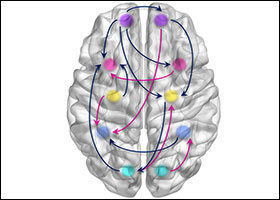Neural Networks and Connectivity among Brain Regions
A special issue of Brain Sciences (ISSN 2076-3425). This special issue belongs to the section "Computational Neuroscience and Neuroinformatics".
Deadline for manuscript submissions: closed (31 July 2021) | Viewed by 36597

Special Issue Editors
Interests: physiological modeling; computational neuroscience; neural networks; multisensory integration; semantic memory; brain rhythms; Parkinson’s disease
Interests: computational neuroscience; multisensory integration; electroencephalography and brain rhythms; connectivity; biomedical signal processing
Interests: network medicine; computational biology; bioinformatics
Special Issues, Collections and Topics in MDPI journals
Special Issue Information
Dear Colleagues,
Cognitive phenomena involve the interaction among several mutually interconnected, specialized brain regions. The problem of assessing brain connectivity during different cognitive tasks and of building biologically inspired neural networks of interconnected regions is thus playing a crucial role in neuroscience today.
The aim of the present Special Issue is to provide a general overview of recent signal processing and mathematical modeling techniques useful to assess brain connectivity, and to simulate the behavior of large interconnected brain regions during relevant cognitive problems.
Cutting-edge research topics can include: i) theoretical overviews of advanced techniques for functional or effective connectivity estimation starting from neuroelectric and/or functional neuroimaging data; ii) experimental assessment of brain connectivity networks involved in different cognitive problems (such as semantic and working memory, spatiotemporal episodic memory, multisensory integration, conflict resolution, fear conditioning, emotion and language); iii) neural networks, inspired by neurobiological data, to simulate the behavior of the brain in some of the cognitive problems mentioned above and to study the origin of brain rhythms and the assessment of their role in cognition; v) use of the previous techniques to study the alterations in brain connectivity and their role in important neurological problems (e.g., autism spectrum disorders, schizophrenia, Parkinson’s diseases, semantic dementia and Alzheimer’s, epilepsy).
Both original experimental and theoretical papers on the previous subjects, as well as review papers are solicited.
Prof. Dr. Mauro UrsinoGuest Editor
Dr. Elisa Magosso
Dr. Manuela Petti
Co-Guest Editors
Manuscript Submission Information
Manuscripts should be submitted online at www.mdpi.com by registering and logging in to this website. Once you are registered, click here to go to the submission form. Manuscripts can be submitted until the deadline. All submissions that pass pre-check are peer-reviewed. Accepted papers will be published continuously in the journal (as soon as accepted) and will be listed together on the special issue website. Research articles, review articles as well as short communications are invited. For planned papers, a title and short abstract (about 100 words) can be sent to the Editorial Office for announcement on this website.
Submitted manuscripts should not have been published previously, nor be under consideration for publication elsewhere (except conference proceedings papers). All manuscripts are thoroughly refereed through a single-blind peer-review process. A guide for authors and other relevant information for submission of manuscripts is available on the Instructions for Authors page. Brain Sciences is an international peer-reviewed open access monthly journal published by MDPI.
Please visit the Instructions for Authors page before submitting a manuscript. The Article Processing Charge (APC) for publication in this open access journal is 2200 CHF (Swiss Francs). Submitted papers should be well formatted and use good English. Authors may use MDPI's English editing service prior to publication or during author revisions.
Keywords
- brain mapping
- functional connectivity
- effective connectivity
- neural networks
- neurocomputational models
- cognitive neurodynamics
- neurodynamical diseases
- neurodegenerative disorders
- brain circuits and synapses
- MRI, fMRI
- EEG, MEG
Benefits of Publishing in a Special Issue
- Ease of navigation: Grouping papers by topic helps scholars navigate broad scope journals more efficiently.
- Greater discoverability: Special Issues support the reach and impact of scientific research. Articles in Special Issues are more discoverable and cited more frequently.
- Expansion of research network: Special Issues facilitate connections among authors, fostering scientific collaborations.
- External promotion: Articles in Special Issues are often promoted through the journal's social media, increasing their visibility.
- e-Book format: Special Issues with more than 10 articles can be published as dedicated e-books, ensuring wide and rapid dissemination.
Further information on MDPI's Special Issue polices can be found here.







